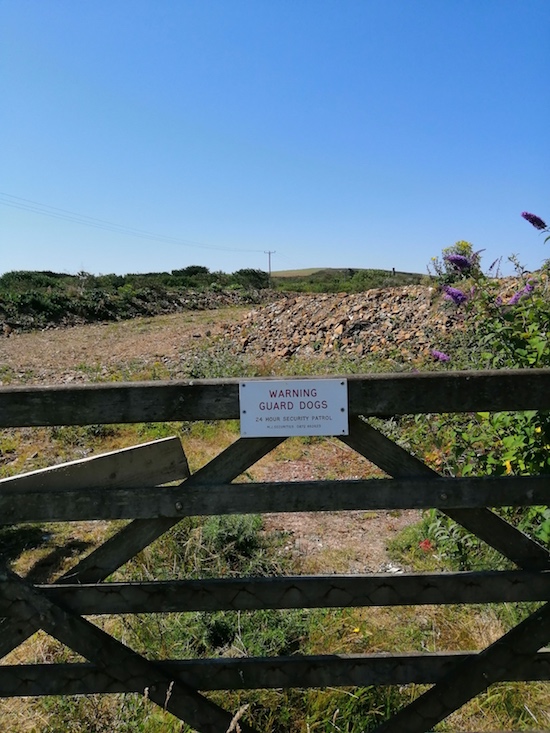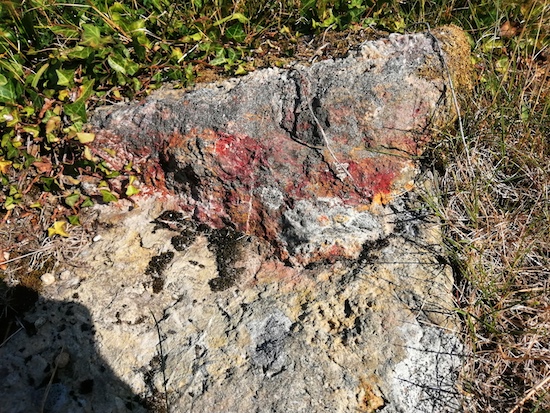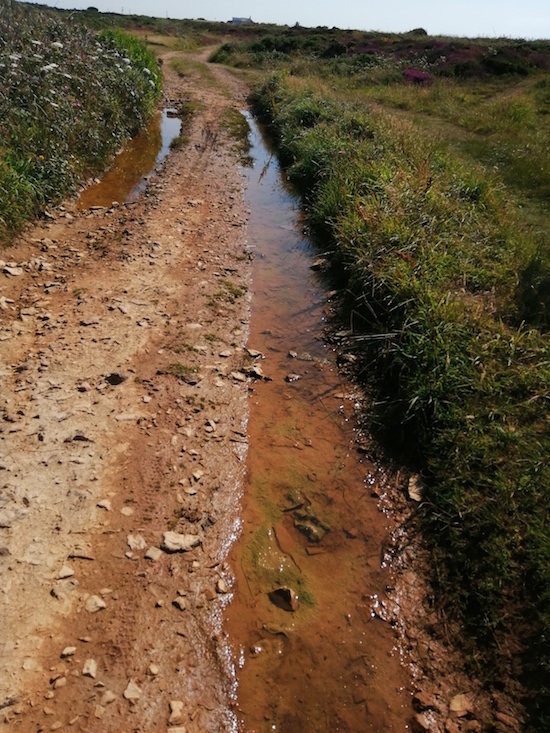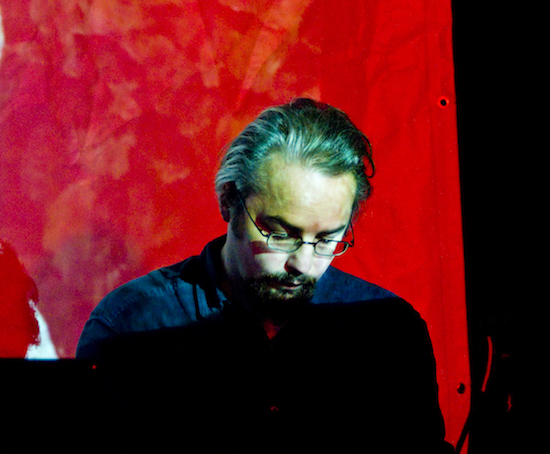Live photograph by Jonathan Carpenter. Landscapes by Kemper Norton
Kemper Norton is a musician who was born and grew up, for the most part, near the Cornish coast. He had a peripatetic young adulthood – though never strayed that far from the sea – and now lives with his family in Portslade just outside of Brighton. A musical autodidact, he has forged a sound out of elements that include folk, ambient electronica, noise and DIY psychedelia.
His previous records have all come with lightly sketched narratives, enhanced by the inclusion of traditional song and field recordings taken at places of significant personal interest. The Lowermoor EP was inspired by the 1989 poisoning of the Camelford water supply and Toll partially concerned itself with the Torrey Canyon oil spill of 1967, so there is undeniably a political element to this music. However Hungan from 2017 took as its theme the story of the semi-legendary 18th Century pirate, Cruel Coppinger, so at the same time, it’s clear what he does is not didactic like traditional protest music.
It is a sound that concerns place and time so it’s fair that the twin terms of psychogeography and hauntology crop up in relation to what he does but, to my ears at least, Kemper Norton’s music sounds quite different to the sonic spectres or audio pathways that these terms usually conjure in the mind’s ear. It is ambient in the sense that it has something of the atmospheres and characters of the places in which it was (partially) made but these are still heavily impressionistic landscapes not highly detailed figurative scenes. Well, this is how I see it at least – maybe some listeners do find themselves exclaiming: "Yes! This conjures the exact vibe of an oil tanker running aground in the late 1960s!" His releases are not ambient in the sense that they are designed to be played in the background in a space, or that they belong to some hidebound fetishised subcategory like dark ambient. It is, at times, noise music but not in any kind of self-lacerating or macho way. What he produces is not binary music or easy to pin down. However, his output isn’t difficult in that, mainly he uses textural (and some subtextual) complexity as a tool to avoid easy (to bracket or interpret) listening, rather than challenging musical composition.
His latest album, Brunton Calciner references a particular aspect of the history of mining in Cornwall. Calciners were large industrial structures used for roasting ore to remove arsenic via a process of crushing and burning using a rotating steam driven drum and a series of chimneys. The resultant thick soot was re-roasted in a bottle furnace producing a white powder which was 99.5% pure arsenic. (In alchemical practice, calcination was, it’s interesting to note, also one of the so-called 12 "vital processes" by which base material could, apparently, be transformed into gold. Arsenic was once an industrial by-product that eventually earned mine and calciner owners a lot of money.) The substance was mainly used in dyes, paints and pesticides but that this toxic substance retains a fascinating aura today is probably related to its associations with sex, death and narcotic derangement. (It was an aphrodisiac, an instrument of both murder and accidental death and a briefly popular recreational drug.) Such was its relative popularity in inter-family murder at one point in 17th Century France, that the substance picked up the nickname, "inheritance powder".
In relative terms the sound has moved on in keeping with the theme of the album. As Bernie Brooks’ excellent review for this very site states, Brunton Calciner "often radiates an almost industrial heat" and the elemental and geological sound set of Hungan has been augmented with more manmade-sounding textures.
Back in 2015 Kushal Gaya of Zun Zun Egui and Melt Yourself Down talked about his notion of a Mauritian proto-industrial music that had existed for well over a century. He was talking about workers in sugar cane plantations who would sing folk song to the rhythm of the loud machinery they were positioned near. Kemper Norton looks obliquely at a similar idea on Brunton Calciner. As on previous albums he has included a traditional folk song, the bawdy and euphemistic ”Sweet Nightingale’ also known ‘Down In Those Valleys Below’ and it too raises the idea of a proto-industrial music existing well before 1976. As the Bandcamp page states: "Sweet Nightingale" ( trad) is arranged for mine works and diamond-cutter by Kemper Norton."

While listening to what is initially an a cappella rendition, we are perhaps invited to imagine a miner hard at work at a seam deep below the Cornish landscape, with his amour up overground in the forefront of his mind. It’s a song that has a natural irony beyond the imagery of the valleys; there is an altogether more earthy interpretation of the lyrics lurking just below the verdant surface. As mentioned arsenic was as an ingredient in a quack aphrodisiac, (should you have had the misfortune to not be as lusty as a Cornish miner) but was also a relatively effective treatment for the syphilis that was rampant in cities like London. The noise of the ore extraction machinery gradually swells across the length of the track until it temporarily summons the idea of a strange four dimensional graph linking the complex relationship between English geography, land ownership, class, sex and EL Rostow’s model of economic take off.
Momentarily the song looks back to the industrial scale leaching of Cornwall from a modern vantage point where the Brunton calciners themselves have calcified, now seemingly as much part of the natural geology as the Devonian crags and igneous outcrops they nestle among. Is this song acting as a clue to how one of the richest mineral areas in the known world became one of the poorest regions in Europe in such a short amount of time? Is this about recent history or is it about what is about to befall us? Both, I’d wager.
You can hear why it’s tempting to talk about ghosts when it comes to Kemper’s music. I’ll go as far as saying it’s certainly eerie, in the sense that Mark Fisher used in his excellent The Weird And The Eerie in 2017: "The eerie is… fundamentally to do with the outside, and here we can understand the outside in a straightforwardly empirical as well as a more abstract transcendental sense. A sense of the eerie seldom clings to enclosed and domestic spaces; we find the eerie more readily in landscapes partially emptied of the human. What happened to produce these ruins? This disappearance? What kind of entity was involved?"
Before adding: "These questions can be posed in a psychoanalytic register… but they also apply to the forces governing capitalist society. Capital is at every level an eerie entity: conjured out of nothing, capital nevertheless exerts more influence than any substantial entity."
Unless there is an issue of, say, language difficulty or extreme inaccessibility in global terms, I don’t personally hold with email interviews, as they can often end up little more than questionnaires that flatter neither the interviewee or the interviewer. However, due to extremely pressing personal issues, this is how this interview had to be conducted. Each question was sent individually after the previous one had been answered, so that it was, in effect, a conversation. Just perhaps a conversation of an older sort. And I think it turned out well regardless.
I’ve been reading a lot about the history of Cornish mining recently so I was quite interested to see that your new (and excellent) album is called Brunton Calciner. Can you explain the etymology of this phrase.
Kemper Norton: The Brunton calciner was a piece of industrial machinery used mainly in the 19th century to process the waste products of tin mining in order to produce arsenic. At the time Cornwall and Devon produced the vast majority of the world’s arsenic, mainly for a range of everyday industrial and domestic uses. As you’d expect the toxic effects of these processes on the workers and the immediate environment were considerable. Remains of Brunton calciners litter Devon and Cornwall, including several near my childhood home and they’re a key part of the post-industrial landscape. As my new album ended up being concerned with processes and physical transformations, and I was already fascinated with Cornish landscape and history (as well as the history of arsenic) the Brunton calciner seemed an obvious totem or portal. (As an older-than-average new father the concept of a redundant machine slowly falling apart having served its purpose also has some resonance I suppose!)
My research tells me that the ‘iconic’ thick crimp of the Cornish pasty is a piece of exceedingly clever design. The pasty was essentially an edible lunchbox for Cornish miners but because there was a high likelihood that their hands would have arsenic on them, the crimp was essentially a handle which would then be cast down the mine shaft after the meal was finished. But not everyone wanted to avoid ingesting arsenic did they? I believe in Victorian times it was also used as an illicit drug in some circles…
KN: Yeah, and supposedly you gave the crust to the piskies and spriggans, although like many areas of pasty lore this is still disputed as miners may well have needed to have eaten all of it. Also the miners could initial the crust to make sure everyone got the right one. This tradition continues in a different vein today – in our village bakery the vegan pasties or the chorizo ones get a special mark.
Arsenic was endemic in Victorian life in so many ways. As well as an occasional aphrodisiac, it was used in the manufacture of wallpaper as well as in a range of medicines and fabric dyes. William Morris used arsenic in his designs from time to time. And because it was soluble, looked like sugar (and was often stored near the sugar and flour in the home) it caused a tremendous amount of accidental poisonings (as well as several that were less accidental).
Arsenic in the Victorian era links to so many emerging areas in society as well. The rise of tabloid journalism is one of these as the popular press covered the more grisly arsenic poisonings (especially if committed by women). The substance also has links to the early days of forensic science and sophisticated criminal investigation. It was also key to producing specific colours for branded products, not to mention industrial pollution and the effects of cost cutting in mass production. All this from a byproduct of mining in a very specific area of the West Country.
Have you read Bruce Robinson’s They All Love Jack? He fingers Michael Maybrick – the Masonic Ed Sheeran of his day – not only for the The Ripper slayings but also for killing his brother James Maybrick – a chronic arsenic addict who had probably worked out the real identity of Jack – and framing his wife, Florence for that murder (this was made all the more easy, like you say, by the tabloid obsession with such cases). Whether you believe Robinson’s account or not it paints a vivid picture of how engrained arsenic use actually was in Victorian times. Perhaps you could say it was the modern equivalent of Oxycodin, Fentanyl or some other powerful opioid. Also these kind of testimonies reveal how much prosperity the arsenic trade would have brought into Cornwall and Devon in the mid 19th century don’t they?
KN: I haven’t read the Bruce Robinson but sounds fascinating! Arsenic was a strange mix of domestic substance, industrial product, weapon of choice, hipster drug and waste product. Like glue I suppose but with more (partially retrospective) glamorous associations. And of course at the time the mining areas of Cornwall were among the richest in the world.
Yeah, it’s crazy now, looking at Redruth and all of the problems it has (which will undoubtedly get much worse if we end up crashing out of the EU with no deal) to think that it was once known as the Copper Kingdom due to its mineral/resource richness. When you end up with a theme like the arsenic industry and the idea of calciners as industrial technology, are there any concrete ways in which this informs the music you make? (Field recordings and the like for example.)
KN: In some previous works (Carn or Toll for example) the concept, a story and other audio such as field recordings came first and were the foundations of the album. Recently however I’ve drifted away from that way of working and with Brunton Calciner, I ignored any grand concept or narrative and ended up just carving away at tracks without much initial thought. Many of these tracks were based entirely on a single sample. For example ‘halan 1’, ‘halan 2’, ‘halan 3’, ‘incence’, ‘exprence’ and ‘incexprence’ are entirely built on the granular transformation and layering of a single key sound. I loved this singular and restricted way of working and it was only after a while that these processes felt linked to and symbolic of the industrial processes and post-industrial nature of where I grew up. The motif of the Brunton calciner then appeared and seemed to grow, fit and help shape the rest of the work. That allowed more specific sounds and songs to demand inclusion.

As is your wont, you’ve included a lovely, gauzy, haunting version of an old song on the album, this time ‘Sweet Nightingale’ which sometimes traditionally goes by the name of ‘Down In Those Valleys Below’; I believe the zesty lyrics can be taken quite euphemistically…
KN: Like a lot of folk songs, and specifically like several other Cornish folk songs , it’s quite bawdy and not that subtle. I’ve always loved the tune to " Sweet Nightingale " and how its delicate melody and the image of the nightingale seems to clash with the other content of the song. The reason it ended up on the album (and specifically at its centre) is that it was often sung by Cornish miners while they were working… I liked its escapist nature and the idea of some beauty down there. Of course in my version it’s backed by underground industrial ambience, falling rocks and the sound of a diamond-cutter so I may have disturbed that beauty a little bit.
You’ve said in the past that you’re interested in the uncanny in the Cornish landscape – can you expand on that a bit please.
KN: It’s one aspect of what I find interesting in the Cornish landscape. As a child and teenager I didn’t know anything about the industry or the history which informs the landscape of north Cornwall in particular, I just found it overwhelming and alive. If you define uncanny as eerie, unsettling or mysterious, then that was certainly how I felt and still feel about areas such as Penwith, the St Austell clay district, the Lizard peninsula or the cliffs around Trevaunance Cove. Discovering more about the landscape’s social and physical history and present has made my responses to these places and my work more complex, and possibly it’s made my work less straightforwardly romantic or perhaps it has focused it on the supernatural and the inhuman, on post-industrialisation, the history of fishing communities, poverty and gentrification as well as the occasional ghost!
I believe you were in the same year at the same school as Richard D James. Can you hear any kind of ‘Cornishness’ to his music, or in a more subtle way do you recognise how your local landscape has influenced his (or your) music?
KN: I think he was at the other school in Truro. I was far too uncool to have any idea about what he was up to. Luke Vibert was at my 6th form though. He was in charge of the common room tape player.
I’m not sure if I would identify a specifically Cornish element to his music, any more than I hear any Devon in Muse, but I think as he himself has said it’s more the physical and cultural isolation from big cities and musical scenes that helped make his work unique. The landscape’s definitely explicitly influenced my work and I’m on record as saying that, for me, an early goal in music was to try and describe it in sound, but I’ve also been affected by life events, other music, film, TV and indeed other areas and countries I’ve lived in. Cornwall’s obviously a famously dramatic landscape, but I’m sure that musicians from Kent, Shropshire, London and Birmingham are just as influenced by what’s around them and find beauty and eerie elements as well as history and folklore in the places they grew up and live in. I feel Cornwall’s one of those counties which is sometimes granted a kind of supernatural mystical status which I think can both simplify its actual nature and the complex range of global influences and identities of other counties, cities and towns in the rest of the country. But yes, I definitely recognise that the physical nature of the landscape of my childhood has been a key influence.
As one inventor of niche genres to another (!) do you still describe your music as slurtronic?
KN: Not at all. It was kind of a stupid joke made long ago to try and stop the music being described as folktronica or whatever other description was floating around at the time! I don’t mind it too much though. A friend who’s released some of my stuff always says that he hates being asked to describe my work as it doesn’t fit too neatly or simply into any single category, which of course I think is ideal.
My stuff used to be associated with hauntology as well, which I guess is inevitable as it’s generally electronic music that deals with folklore, history and the supernatural, but the cultural signifiers and technologies of that movement (1970s TV, the Radiophonic Workshop, vintage synths etc.) aren’t anything I was influenced by or am particularly interested in.

You’ve told me a couple of times during the course of this interview that you’ll get back to me after you’ve taken your two-year-old daughter to the park and after you’ve dealt with her birthday party. My own experiences of becoming a parent are the opposite of that hoary old Cyril Connelly quote about the pram in the hallway being the death of art. But it does affect what you do, being a parent, doesn’t it? What are some of the more unexpected ways in which becoming a dad has affected your artistic practice.
KN: It’s affected me in every possible way and most of those are beyond words. I would assume for a number of reasons that it’s much easier for a father than a mother to be able to say that a child didn’t prevent them continuing with their creative work, and I have managed to carry on with mine. Hungan (the album I made in 2017 while waiting for Iris to be born) was explicitly concerned with impending parenthood and change at macro and micro level, including a narrative about an evil father figure and samples of her heartbeat running across several tracks. Now she’s here as an actual living presence and growing person my daughter colours everything I do, think and feel so inevitably the work has also continued to be affected. Making music is pretty small beans compared to being a parent and as time is precious I’ve been less concerned with dreaming up grand conceits or narratives for my music. It feels a bit more everyday and more like an organic process. One thing that did happen after her birth was a sudden dramatic shift in my responses to violence and gore in film and literature. I could no longer handle such scenes and despite some of my favourite works and genres being quite violent I suddenly found I was affected deeply and negatively by anything concerning physical pain or suffering. A friend of mine suggested that witnessing a fairly eventful birth was the "rediscovery of physical fragility" and this makes sense.
I can’t even imagine how a mother of even a successful and straightforward delivery may be affected; my role in my daughter’s birth was essentially as a bystander!
I spoke to you earlier in the year for the New Weird Britain series I made with Alannah Chance for BBC Radio 4; did you have a sense of spirit d’escalier afterwards? Anything you wished you’d said, or has hearing the series sparked any more thoughts about the idea of odd DIY music being made outside of metropolitan centres in the UK?
KN: I was delighted to contribute to the show but at the time didn’t have any particular strong feelings about "New Weird Britain" as a concept. However since then and hearing the excellent shows, I’ve been remembering events I’ve been lucky to participate in such as Supernormal, Wyrd Wild West, the Todmorden Tor Ist Das festival and Fano Free folk festival. There is such a great network of varied and interesting underground artists, and recently playing at Delaware Road and seeing old friends, new friends and performers I admire such as Sarah Angliss, Ekoplekz, Lone Taxidermist, R.E.EL, Embla Quickbeam, Alison Cotton and Howlround reminded me how important and life-affirming music, creativity and community at its best can be. Outside of my own fairly narrow orbit there’s tons of fascinating stuff happening in other genres such as the weird world of Blah Records in UK hiphop. Musicians from all corners of Britain and beyond are making great stuff with a range of tools, talking to one another, collaborating with each other and supporting each other… It’s fantastic.


